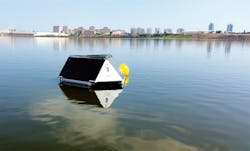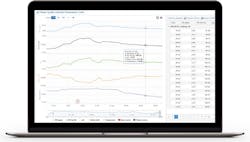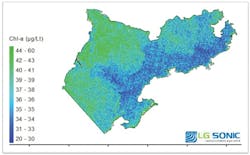That-a-Bouy
Lisa Maria Brand is microbiologist and CTO for LG Sonic. Brand can be reached at [email protected] or +31 (0) 70-7709030.
undefinedAlgal growth in raw water used to produce drinking water often leads to several quality and operational problems in treatment plants. The town of Emmitsburg, Md., has moved away from using copper sulphate to solve this problem in its 11-acre drinking water reservoir called Rainbow Lake. Instead, it implemented an environmentally friendly and solar-powered solution provided by LG Sonic to monitor and control algae before it enters the treatment plant.
The town has had several issues with algal growth, mainly during the summer months, which have led to an increase in chemical use in the treatment plant to deal with the high levels of organic material in the water. In addition, water consumption during algal bloom events increases as filter run times decrease. Copper sulphate had been used to control the algae, but this had to be discontinued due to a change in permits. Alternative chemical treatments in Rainbow Lake underperformed, and chemical solutions to control algal blooms also could impact the ecological balance of a water body. Effects of chemical algal control can include toxicity or lysis of the algal cells and non-target responses, which lead to degradation of the overall water quality.
In collaboration with Kershner Environmental Technologies, Emmitsburg installed an MPC-Buoy system in Rainbow Lake in April 2017 to continuously monitor and control algae. The name of the MPC-Buoy, manufactured by LG Sonic in the Netherlands, stands for monitor—predict—control, and the system can reduce algal concentrations 70 to 90% in an environmentally-friendly manner. LG Sonic has researched the effects of ultrasound on specific algal types, different types of water bodies and variations in water quality since 2005. In collaboration with several European universities, it created a database that defines optimal ultrasonic parameters for different algal species and water quality characteristics. By continuously updating these ultrasonic parameters, the system prevents algae from becoming resistant to ultrasound.
For the collection of in-situ water quality data, near-real-time sensors are used to measure pH, chlorophyll a, phycocyanin, turbidity, dissolved oxygen and, optionally, nitrogen and phosphorous. Based on this information and algal bloom forecasts, the buoy automatically changes the ultrasonic parameters that it sends out. This is called interactive algae control.
Ultrasound Algae Control
The buoy system uses low-power ultrasonic algae control. This specific ultrasonic mechanism does not cause the algal cells to lyse and does not affect multicellular organisms. Algae rely on buoyancy to float close enough to the water surface to take up sunlight. This allows them to outcompete other organisms in the water, such as plants, that also depend on sunlight intake. The ultrasound used by the buoy system fixes the algal cells in the water column, preventing them from absorbing sunlight at the surface.
Rainbow Lake Results
To assess the effect of the buoy at Rainbow Lake, the town compared data from the same months in 2016 without the buoy and in 2017 with the buoy installed. The main data included water usage, number of backwashes, employee overtime and chemical costs. Emmitsburg town manager Cathy Willets told the commissioners that “they did see a significant improvement in water quality.”
Although the number of filter backwashes in the plant did not decrease, water usage for backwashes decreased from 19.71% in 2016 to 14.08% in 2017, meaning less water was required to clean the roughing filters. The amount of water used for backwashes was reduced from 1,459,888 average gal per month in 2016 to 1,075,000 average gal per month in 2017, for a total reduction of 384,888 gal per month, or 26.4% savings.
Additionally, the chemical costs of the plant were reduced by 27% compared to 2016. The main savings in chemicals were:
- Algaecide that normally would be dosed in Rainbow Lake: 100% reduction;
- Chlorine usage: 26% reduction; and
- Soda Ash (water softener): 21% reduction.
Coagulant use and diatomaceous earth use slightly increased, by 3.8 and 0.42%, respectively.
Other improvements in plant operations occurred with the average flow from the lake, which exceeded the target flow of the treatment plant. Additionally, overtime work at the water plant was reduced by 31%, saving nearly $3,000.
As a general conclusion at the town meeting, the staff mentioned the buoy has worked and has been beneficial to water operations by reducing chemical usage, cutting down on overtime and saving water otherwise used for backwashing.
Algae Monitoring & Prediction
In addition to providing a solution for algal control, the MPC-Buoy system also provides real-time water quality monitoring. This data is accessible to lake operators through an algae management software called MPC-View. Together with several European companies and research institutes, LG Sonic has developed an automated algorithm that can forecast algae blooms between three and 10 days in advance. Data provided by the buoy systems can be used as a source for this algorithm, together with meteorological data and remote sensing satellite imagery.
Remote sensing uses images provided through satellites in combination with a set of algorithms to analyze specific water quality parameters, including algal concentration over a spatial surface, such as a lake. The use of remote sensing has an advantage when forecasting algal blooms, specifically scum layers, because remote sensing is the only data source that provides a spatial overview of water quality parameters over the entire lake.
By combining these data sources into one algorithm, LG Sonic can provide a three- to 10-day prediction of algal and cyanobacterial blooms. Further, the U.S. EPA has begun using a monitoring program to analyze algal toxins and set federal standards. Using the buoy and algal prediction, the possibilities of toxin occurrence can be predicted and effectively prevented.


